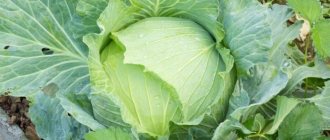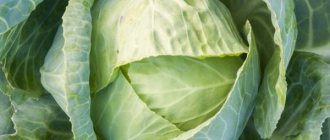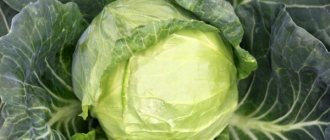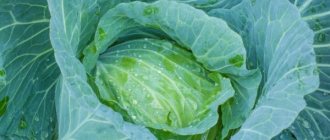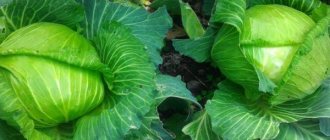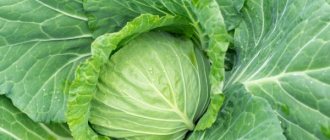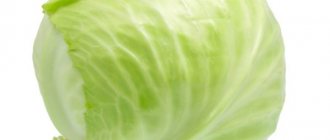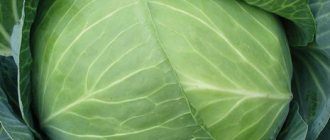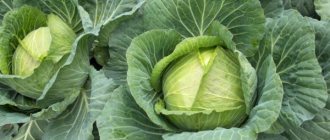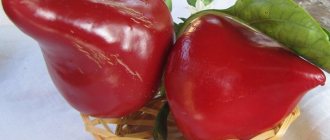Mother-in-law cabbage is a mid-season variety of white cabbage with a universal purpose. It tolerates the conditions of central Russia well, produces a rich harvest, and with proper care you can get very large heads of cabbage. The pulp has an excellent taste after any type of processing.
| Landing location | Ripening time | View | Purpose | Origin | Maturation period | Weight |
| Open ground | Mid-season | White cabbage | Fresh, Pickling, Pickling, Short-term storage, Cooking, Processing | Variety | 120-140 | 2-8 |
Planting seedlings
Growing seedlings lasts 115 days. This method requires a lot of work - you need to grow seedlings, pick them and transplant them into open ground.
How to transplant cabbage seedlings of the Megaton variety into open ground, see the video below:
How to sow seeds for seedlings?
Seeds for cabbage seedlings should be sown from mid-March to the third ten days of April. They grow seedlings in separate glasses - then they skip the picking stage. If seedlings are grown in boxes, after a certain time they have to be planted in pots.
Seeds are prepared for sowing in the usual way - hardened and disinfected. Sowing order:
- The seeds are sown in containers filled with substrate - you can buy it or prepare it yourself. The soil mixture is prepared by mixing humus, sand and turf soil in equal parts. The resulting mixture is disinfected with Fitosporin.
- Place two or three seeds in one glass. Seeds are sown in a row at intervals of 1 cm - this is when sowing in boxes. Between rows - 3 cm.
- Cover with soil, moisten with a spray bottle and cover with film. Until the shoots appear, the container with the crops is kept warm - at a temperature of +20-25°C.
- After 4-5 days, sprouts appear. If seedlings are grown in boxes, the seedlings are thinned out, increasing the gaps between neighboring seedlings to 2 cm. If seedlings are grown in glasses, only one sprout is left - the healthiest and strongest is chosen.
- The seedlings are watered with warm water as soon as the top layer dries.
- Thinned seedlings are placed in a room or greenhouse - during the day the temperature there should be maintained at +18...+20°C, at night - +12...+15°C. Temperature changes are necessary to harden seedlings.
- If necessary, turn on additional lighting to extend daylight hours. With a lack of light, seedlings stretch out and weaken.
It is recommended to sow seeds for seedlings several times - so that the newly growing seedlings can replace those that cannot take root in the beds.
How to pick seedlings?
Picking is carried out after the appearance of the third true leaf. Seedlings from the box are transplanted into glasses. But first the soil is watered to make it easier to remove them. Seedlings are planted in pots, buried to the level of cotyledon leaves.
How to feed the seedlings?
While the seedlings are growing, until they are transplanted into open ground, fertilizing is carried out three times.
Frequency and composition of fertilizers for seedlings:
Features of harvesting and storage
Ripe cabbage is cut off with a sharp knife, leaving 3–5 cm of the fruit stem. After cutting the heads of cabbage, the stems are dug out along with the roots. For saving, undamaged, dense heads of cabbage are selected
Before storing, special attention is paid to inspecting the vegetables for the presence of moisture on the surface of the cabbage heads (the slightest drops can lead to the appearance of fungus).
Important! The optimal storage temperature for fresh cabbage is 0°C, and air humidity is at least 80%.
Storage periods vary depending on the location of the pumpkins:
- When stored in a cellar (in boxes, in parchment paper or in sand), cabbage retains its taste and presentation for the longest time (up to six months).
- You can also store the heads of cabbage on the top shelf of the refrigerator, having previously wrapped them in cling film. In this case, the cabbage will delight you with excellent taste for about a month.
- If you don’t have a cellar or enough space in the refrigerator, you can store the cabbage in the pantry or on an insulated balcony. If the microclimate parameters are observed, Menza will remain fresh at least until the New Year holidays.
The currently popular freezing method is also suitable for cabbage. You can freeze both whole heads of cabbage and chopped leaves. The freezing temperature is –18°C. The disadvantage of this method is the loss of “crispness” and, to some extent, presentation after defrosting. However, the taste remains unchanged.
Menza leaves are not only an ingredient for salads and cabbage rolls. This hybrid is great for pickles and pickling. Pickling involves preserving cabbage with table salt. Salted cabbage, sealed in jars, can be stored until summer, even at room temperature. Unlike pickling, the classic recipe for sauerkraut involves fermenting under pressure for 2–7 days, followed by storage at a temperature not exceeding 0°C.
Characteristics of the variety
Wintering is a late-ripening, high-yielding hybrid of white cabbage. The growing season lasts 120-150 days. Productivity is in the range of 5-7 kg per 1 m2.
The rosette of leaves is small, semi-raised. The leaves are large, round in shape, gray-green in color. The leaf is covered with an intense waxy coating. The leaves have a wrinkled structure and pronounced waviness at the edges.
The heads of cabbage are flat-round in shape, dense in structure, weighing 2-3 kg. The inner stump is medium or long, suitable for eating. If cabbage is treated with pesticides, then it is better not to eat the core as it accumulates chemicals.
Heads of cabbage are not afraid of mechanical stress and are suitable for transportation over long distances. Also, they are not prone to cracking.
Wintering gives the best harvest when grown on fertile, light loam or loamy soils. When growing cabbage in acidic soil, you will not be able to get a good harvest.
Also, the amount of light the plant receives affects the yield. With its deficiency, the heads of cabbage grow loose and small.
Ideal growing conditions are achieved by observing crop rotation. It is advisable not to grow cabbage in the same place for more than 2-3 years. The best predecessors for this variety are nightshade, pumpkin, legumes and onions.
Due to the fact that wintering is a late variety, it is preferable to grow it through seedlings. The seedlings are transplanted into the OG when they are old enough, at 50-55 days.
The Zimovka hybrid is mainly intended for fermentation and long-term storage in the cellar. Six months after storage, the marketability of the crop is about 80-90%. Under favorable conditions, the vegetable can be stored until June.
general characteristics
When studying the question of what kind of cabbage there is, you should pay attention to its characteristics. All varieties except Peking, leaf, Chinese and colored varieties are biennial plants
When breeding vegetables, this must be taken into account. In the first year, biennial varieties develop a rosette of leaves, as well as storage organs (head of cabbage). To collect seeds for propagation, you will need to wait until next year.
All varieties of cabbage can be divided into 3 groups. The early variety is ready for harvest 2-3 months after germination. Medium varieties produce a harvest after 3-5 months, and late varieties - after 5-7 months.
Depending on the breeding purposes, it is necessary to calculate the collection period. If you need cabbage for fresh salads in the spring, you definitely choose an early type of crop. Late varieties are suitable for harvesting vegetables for the winter.
If you want to plant this wonderful vegetable in your garden, you need to find out where cabbage grows and how to plant its seeds. The ideal time for propagating seedlings is February - May. At the same time, be sure to take into account when to expect the harvest.
It is better to plant seeds in pots with peat. The seedlings do not tolerate transplantation well. That's why they are left in these containers. When the seedlings are 40-60 days old, they are planted in the ground in the container where they grew. You can do this a little earlier, but you need to provide them with the most comfortable conditions possible.
If it is early spring, planting is done in a greenhouse. Here frosts will not damage the seedlings. They will grow in such conditions strong and healthy, ready to grow in open ground.
Planting and care
You can return cabbage to its original place after three years.
Selecting a site, preparing the soil
The Aggressor variety is undemanding in terms of soil composition, but it is still recommended to adhere to crop rotation. The best predecessors are legumes, nightshades and cucumbers.
Scheme and time of disembarkation
A distinctive feature of Aggressor cabbage is its vitality and reliability, despite the vagaries of nature. Thanks to this, it can be grown both in seedlings and without seedlings.
Seedling method
Growing seedlings is the most common way to plant cabbage.
The most common method of growing cabbage is to plant seeds in peat pots, tablets or plastic containers for seedlings. This must be done in early April. The optimal temperature for seed germination is +15…+18 °C.
For good growth and development, seedlings need sufficient lighting and temperature control. It is recommended to take grown plants into a room with an air temperature of +6...+8 °C during the day, or place them on the balcony. At dusk, the seedlings need to be returned to the house. This technique helps to avoid stretching and harden the plants before planting in the garden.
Seedless method
Growing plants need to be trimmed
Seeds should be sown in open ground in late April. The bed must be located on the sunny side. When digging, it would be useful to add a bucket of humus per square meter.
2-3 seeds are planted in each hole. After watering well, it is advisable to cover the bed with film to save heat.
Grown seedlings are thinned out by removing or planting excess.
Seeds and seedlings should be planted according to a 50x60 cm pattern. Also during planting, it would be useful to additionally fertilize each hole with a mixture of 1 part peat and sand, and 2 parts humus, with the addition of a small amount of wood ash.
Watering and fertilizing
After planting the seedlings in a permanent place, it is advisable to feed the plants
In order for the heads of cabbage to form beautiful, weighty and not crack, it is necessary to follow basic rules of care:
- Cabbage requires abundant watering, preferably in the evening or morning. The water should be at room temperature.
- On hot days, plants need to be watered every 2-3 days. In cloudy weather, 1 watering per week is enough.
- After watering, it is advisable to loosen the soil, removing weeds and hilling up the plants.
- To protect against drying out, you can mulch the soil around the seedlings with peat or sawdust.
- You don’t have to use additional fertilizers if you take care of adding organic fertilizers to the garden bed in advance.
Table: fertilizing
| Fertilizing time | Feeding composition |
| A week later, the shoots appeared. | Dissolve 2 g of potassium fertilizer and ammonium nitrate, 4 g of superphosphate in 1 liter of water. This amount is enough for 50 plants. To prevent burns, apply after normal watering. |
| 14 days after the previous feeding. |
|
| Before planting seedlings in the beds. |
|
| As soon as the leaves started to grow. | 10 g of ammonium nitrate per 10 liters of water. Water the seedlings. |
| As soon as the head of cabbage began to form. | 4 g of urea, 5 g of double superphosphate, 8 g of potassium sulfate per 10 liters of water. Water the plants. |
Description of the cabbage variety Mother-in-law
Mother-in-law is a medium-ripening white cabbage variety. It was developed by the famous agricultural company Sedek. The mother-in-law was included in the State Register of the Russian Federation in 2008. Recommended for cultivation in two regions of our country:
In this publication you will find a description of the variety, photos of Teschi heads of cabbage and reviews from those people who have personally encountered domestic cabbage.
Properties
Mother-in-law is a mid-season cabbage. The growing season of the vegetable lasts 125-135 days. Productivity is high. From 58 to 65 tons of high-quality cabbage are harvested from 1 hectare. Of the total harvest, approximately 90% is suitable for sale on the market.
The leaf rosette of the plant is large and raised. The leaves are very large and grayish-green. There is a wax coating on the surface of the sheet. The edge has wavy, but it is very weakly expressed.
The heads of cabbage are large, growing up to 2.5-3 kg (some specimens grow larger). The outer color of the head of cabbage is light green, the inside of the head of cabbage is yellowish-white. Heads of cabbage are characterized by good internal structure and density. Thanks to this, heads of cabbage can be transported over long distances without problems. The taste of the vegetable is rated 4 out of 5.
The chemical composition of this mid-season cabbage is very high. It contains:
- Carbohydrates.
- Cellulose.
- Vitamin B
- Ascorbic acid.
- Potassium.
- Magnesium.
- Phosphorus.
- Calcium.
- Fluorine, etc.
Like many other cabbage varieties, it resists various diseases and insect attacks well.
Mother-in-law cabbage is suitable for large-scale production in the Russian Federation. It is noted for its very delicate taste and good transportability. However, it is worth noting that it has a short shelf life - about 3-4 months.
Positive and negative qualities
Thanks to its positive qualities, it has gained a good reputation among farmers. The main advantages of this variety look like this:
- Excellent taste. When tasting it gets 4 points out of 5.
- Quite large (about 3 kg) heads of cabbage that have a good, dense structure.
- Good immunity that protects the variety from various diseases and pests.
- High yield.
- High percentage of commercial output.
- The variety is excellent for large-scale production.
There are no shortcomings as such. The only thing that farmers may not like is the short storage period of the heads of cabbage, which under normal conditions does not exceed 3 months.
Cabbage care
Sprouts that have become stronger and have taken root in a new place on the exhaust zone need to be watered at least once every 3 days (if it is hot). If the weather is cloudy and cool, then water it no more than once every 5 days.
In addition to watering, do not forget about loosening the soil. The first time the soil is loosened to a depth of 4-5 cm, no more, so as not to damage the root system of the plant. Subsequent loosening is possible to a depth of up to 8 cm.
Also, don’t forget to remove weeds and hill up the cabbage. To reduce the need for moisture and eliminate the processes of clearing weeds and loosening, you can cover the crop with mulch.
The most important step in caring for this vegetable is its fertilization. After planting the seedlings in exhaust gas, they are fertilized twice:
- The first time during the period of intensive growth of leaf plates. Then use the following solution: add 10 g of ammonium nitrate to 10 liters of water. A bucket of solution is used for 6-7 plants.
- During the formation of heads of cabbage, make the following solution: add 4 g of urea, 5 g of superphosphate, 7 g of potassium sulfate to 10 liters of water. A bucket of water, as in the previous case, is spent on 6-7 plants.
Also, during the growing season it is necessary to monitor the growth of the crop. It may be affected by slugs, which are repelled by the tree hall. Also, aphids often settle on cabbage. Aphids can be destroyed with an infusion of tomato tops or onion peels. An infusion of tar soap is also excellent.
If the cabbage has formed heads, then it is advisable not to spray it with pesticides, but to use traditional old-fashioned methods.
Savoy cabbage
Savoy cabbage (photo below) has wrinkled leaves. They are covered with bumps and bubbles. It is eaten fresh or after heat treatment. This vegetable does not last as long as its white relative. But the taste and dietary characteristics are significantly superior to the latter.
Savoy culture has a high content of vitamin C, mineral and protein components. This variety is grown in the same way as previous varieties. It is necessary to take into account the timing of planting its seedlings.
Popular varieties are Mila 1 (3 kg), Yubileinaya 2170 (0.8 kg), Sfera (2.5 kg).
Savoy cabbage, the photo of which was presented above, is distinguished by its dietary qualities, but it is poorly stored. Therefore, housewives began to use a variety such as kohlrabi when preparing various dishes.
This cabbage has a spherical stem. It is used in the preparation of soups and salads. This vegetable produces high yields and a high content of vitamin C. It is grown both in a greenhouse and in the open. Plants are planted at a distance of 25x15 cm.
Harvesting occurs when the stems become 8-10 cm in diameter. In our country, the most commonly grown plants are Picant (0.5-0.9 kg), Vienna white 1350 (up to 2.5 kg).
Cabbage Mother-in-law: description of the variety
Mother-in-law f1 is one of the types of white cabbage produced by the agro-company Sedek at large agricultural firms. Let's consider why Mother-in-law cabbage is interesting and how to properly grow this variety.
Description of cabbage Mother-in-law
Description of the variety
The hybrid variety was officially registered about 10 years ago. Approved in the Volga-Vyatka and West Siberian regions. There is an improved type of this cabbage called Golden Mother-in-law. Having greater productivity, the variety is grown for commercial enterprises.
Variety characteristics:
- ripening time (time from first germination to full maturity) average: 120 – 140 days;
- high yield – 570 – 650 c/ha;
- commercial yield - almost 90%;
- good transportability - cabbage heads do not crack during transportation;
- germination rate is about 95%;
- disease resistance;
- The shelf life is relatively short - 3 months.
Description of the head of cabbage
Lettuce heads of mother-in-law are light yellow when cut, round and even in shape, soft and juicy to the touch. They weigh from 2 to 8 kg, very dense. The inner stalk is small, the outer one is slightly larger.
The cabbage leaf plate is wide, wavy at the edges, slightly bubbly, swamp green in color with a glossy coating. The leaf rosette is slightly raised.
Taste and application
Cabbage of this variety has excellent taste characteristics. The taste is sweetish, sometimes tart.
This variety is consumed raw, stewed and pickled. When salted, cabbage retains its beneficial properties.
Growing cabbage
Give your plants good care
Gardeners sow Mother-in-Law seeds in the ground no earlier than April, waiting for the onset of real warmth. The seedlings are moved to open soil after 55-60 days.
Pre-treatment of seeds is carried out as follows. 10-15 days before planting, it is necessary to begin hardening to increase the further resistance of seedlings to diseases and infections. For several days in a row she is kept for 5-6 hours in a well-ventilated room.
On days 5-6, the seedlings spend 2 hours a day on the balcony, always protected from direct sunlight. In the remaining days before planting, you don’t have to bring the seeds back into the house: let them stay on the balcony all the time.
By that time, the plant may already have its first leaves.
The soil for Mother-in-Law cabbage is selected to be loamy, with an average level of acidity. Sowing depth is 0.5-1 cm according to the 60x60 cm pattern. Plants are buried down to the first leaf. The first shoots should be expected no earlier than in a week. The harvest usually ripens in 4 months.
Seedling care
To get a rich and high-quality harvest of Teshcha cabbage, you should follow certain recommendations.
Watering. It should be regular (so that the size of the head of cabbage does not lag behind the norm), but in small doses. Nutrition of the top fertile layer will help increase fertility. Water for irrigation is taken at room temperature. Hilling. It is carried out twice - 3 weeks after planting and another 12-15 days after the incident. In this way, the plant’s rhizome is strengthened and the growth of heads of cabbage is accelerated. Feeding. Chicken droppings or mullein are suitable as the first (2 weeks after planting). You can use mineral fertilizers - superphosphate, urea, potassium monophosphate. After another 15 days, repeated feeding is carried out, but the doses of fertilizers are increased. Further feeding is only necessary if the cabbage ripens slowly. Hilling
This precaution is needed to protect the plant from weeds, which steal heat and nutrients from it and complicate the processing process.
Diseases and pests
Aphids, caterpillars, and cruciferous flea beetles are the main insects that cause harm to cabbage seedlings. The degree of harm they cause can vary - from affecting the size of the head of cabbage to completely destroying the crop. Garlic broth and tobacco tincture will help in the fight against aphids. For 10 liters of water, 1-1.5 kg of chopped garlic/tobacco.
Caterpillars are usually collected by hand. Soap solution effectively helps against cruciferous flea fleas
These insects reproduce very quickly, so it is important to eradicate all fleas as soon as possible.
Conclusion
Mother-in-law is one of the most popular varieties of white cabbage. By following all the rules of planting and care, you can get a rich harvest from large and healthy specimens. The description of the variety proves that this is an ideal option for both beginners and professionals.
Growing cabbage
Give your plants good care
Gardeners sow Mother-in-Law seeds in the ground no earlier than April, waiting for the onset of real warmth. The seedlings are moved to open soil after 55-60 days.
Pre-treatment of seeds is carried out as follows. 10-15 days before planting, it is necessary to begin hardening to increase the further resistance of seedlings to diseases and infections. For several days in a row she is kept for 5-6 hours in a well-ventilated room. On days 5-6, the seedlings spend 2 hours a day on the balcony, always protected from direct sunlight. In the remaining days before planting, you don’t have to bring the seeds back into the house: let them stay on the balcony all the time. By that time, the plant may already have its first leaves.
The soil for Mother-in-Law cabbage is selected to be loamy, with an average level of acidity. Sowing depth is 0.5-1 cm according to the 60x60 cm pattern. Plants are buried down to the first leaf. The first shoots should be expected no earlier than in a week. The harvest usually ripens in 4 months.
Read also: Crispy gherkins for the winter
Features of agricultural technology
Following the rules of caring for varietal seedlings allows you to get a bountiful harvest. This variety is good because it is suitable for both experienced farmers and novice gardeners who have not previously dealt with this crop. If the owner of the plot is interested in cabbage, the Mother-in-law variety will attract him with its unpretentiousness. This species grows well in loamy soils with an average acidity level. The culture requires good lighting, otherwise the leaves and heads of cabbage will slow down.
It should be noted that in this variety the rosette becomes quite powerful and spreading, so the plant will require space. The seeds are planted in the soil to a depth of 0.5-1 cm. The distance between plantings should be such that the ripening heads of cabbage do not interfere with each other (maximum 3 pieces per 1 sq.m.). The first shoots usually appear no earlier than a week later. The harvest in a cabbage bed ripens in about 4 months.
Important! Before planting in the soil, the seeds must be treated. Two weeks before planting in the ground, hardening begins to increase the plant's resistance to diseases. Seeds are immersed in a weak concentration of potassium permanganate solution (no more than 5 g per 0.5 liter of water)
Processing time is 20 minutes. After this, the seeds are thoroughly washed
The seeds are immersed in a weak concentration of potassium permanganate solution (no more than 5 g per 0.5 liter of water). Processing time is 20 minutes. After this, the seeds are thoroughly washed.
When growing this variety, you should adhere to the following recommendations:
- Watering must be regular so that the size and other parameters of the head of cabbage do not lag behind the norm. To do this, use water at room temperature,
- Hilling the cabbage is done twice. The first time this is done three weeks after planting, the second time after another two weeks. This helps strengthen the rhizome of the plant and accelerate the growth of heads of cabbage. In addition, hilling allows you to protect cabbage from weeds, which could take away nutrients and heat from the soil,
- feeding This variety requires the use of different types of fertilizers - mineral and organic. In the first case, chicken manure is used, in the second - potassium monophosphate, superphosphate, etc. After two weeks, you can re-feed, slightly increasing the dosage of fertilizer. There is no further need for fertilizing, except in cases where the heads of cabbage ripen too slowly.
It is also necessary to control pests. The main threats are caterpillars, aphids, and cruciferous flea beetles. They reduce the quality of the crop and its quantity, and can affect the reduction in the size of the head of cabbage. You can fight them not only with the help of pesticides, but also by using natural remedies - garlic infusion or tobacco tincture. They are prepared in the same way - 1-1.5 kg of the active ingredient (peeled garlic or tobacco) per bucket of water. Cruciferous flea beetles are removed using a soap solution, and this must be done promptly, since they multiply quickly. But the caterpillars will have to be collected manually.
Cabbage Mother-in-Law
Properties
Mother-in-law is a mid-season cabbage. The growing season of the vegetable lasts 125-135 days. Productivity is high. From 58 to 65 tons of high-quality cabbage are harvested from 1 hectare. Of the total harvest, approximately 90% is suitable for sale on the market.
The leaf rosette of the plant is large and raised. The leaves are very large and grayish-green. There is a wax coating on the surface of the sheet. The edge has wavy, but it is very weakly expressed.
Read also: Bench or bench, what’s the difference?
The heads of cabbage are large, growing up to 2.5-3 kg (some specimens grow larger). The outer color of the head of cabbage is light green, the inside of the head of cabbage is yellowish-white. Heads of cabbage are characterized by good internal structure and density. Thanks to this, heads of cabbage can be transported over long distances without problems. The taste of the vegetable is rated 4 out of 5.
The chemical composition of this mid-season cabbage is very high. It contains:
- Carbohydrates.
- Cellulose.
- Vitamin B
- Ascorbic acid.
- Potassium.
- Magnesium.
- Phosphorus.
- Calcium.
- Fluorine, etc.
Like many other cabbage varieties, it resists various diseases and insect attacks well.
Mother-in-law cabbage is suitable for large-scale production in the Russian Federation. It is noted for its very delicate taste and good transportability. However, it is worth noting that it has a short shelf life - about 3-4 months.
Planting care
The yield of the crop will depend on the correct care of the plantings. Cabbage needs watering, fertilizing and prevention of diseases and pests.
Watering and fertilizing
Seedlings are watered in the evening, every 2 days. If the weather is rainy, watering is done every 5 days. Add 1 liter of water to each bush. The liquid should be left standing for 2 days, its temperature should be from +25°C to +30°C.
Important! It is better to fertilize the crop after watering to avoid burns to the root system. Fertilizer application schedule:
Fertilizer application schedule:
- At the beginning of May, you need to apply the first fertilizing consisting of: 2 g of potassium, 3 g of superphosphate, 3 g of nitrate, diluted in 1 liter of water. Apply 50 ml of fertilizer to each bush.
- At the end of May - beginning of June, apply a second fertilizing consisting of: 4 g of potassium, 6 g of superphosphate, 6 g of nitrate, diluted in 1 liter of water. One plant needs 50 ml of fertilizer.
- In mid-June, the third feeding is carried out; it is made from: 10 liters of water and 10 g of saltpeter. Use 2 liters of fertilizer per hole.
- The fourth fertilizer is carried out during the period of active formation of the head of cabbage, it is prepared from: 5 g of urea, 6 g of superphosphate, 7 g of potassium, diluted in 10 liters of water. Use 1 liter of fertilizer per plant.
Weed removal and hilling
After each watering and rain, you need to loosen the soil around the plant. To better retain moisture, the ground can be mulched with peat, a layer of 3 cm. Weeds are removed as they appear. Weeds are uprooted to prevent their further growth.
We recommend reading how and when to pick leaves from cabbage.
Hilling of cabbage is carried out 15 days after planting in open ground. The soil is tucked under the bush to provide support for fragile leaves and also to prevent the legs from bending. Subsequent hillings are carried out at intervals of 3-4 weeks, in order to saturate the soil with oxygen and prevent the formation of mold on the rhizome.
Disease and pest control
The most dangerous diseases for vegetables are downy mildew and Alternaria.
Powdery mildew is a fungal infection that appears as gray or yellow spots on the outside of the leaf blade. A whitish coating forms on the underside of the leaf. As a result of infection, the leaves wither and die, and plant growth slows down.
Measures to combat the disease:
- Disinfection of soil and planting material with a slightly pink solution of potassium permanganate.
- Treatment of plants with a 1% solution of Bordeaux mixture (100 g per 10 liters of water).
- Loosening the soil around the plant.
Alternaria is a type of fungal infection that occurs when there is high humidity. Fungal spores can be carried by wind or droplets of water. The disease can be recognized by black dots, which over time become larger in size and become covered with mold. The leaves rot and become unfit for consumption.
Fighting Alternaria:
- When planting seedlings, 20 g of wood ash must be placed in the hole.
- The soil around the plant needs to be loosened and weeds removed.
- Every 15 days, vegetables and the soil under them should be irrigated with a solution of copper sulfate (100 g per 10 liters of water).
We recommend reading how to fight aphids on cabbage.
Fighting aphids:
- Removing weeds from the area.
- Manual harvesting of leaves affected by the pest.
- Spraying with a soap-ash solution: 300 g of soap, 300 g of ash per 10 liters of water. Irrigation is carried out in the morning and evening, for 3 days. After 7 days, the procedure is repeated.
Cauliflower
When considering what types of cabbage there are, one cannot ignore another popular variety. Its head, when eaten, looks like a greatly expanded inflorescence. This is where the name of the variety comes from. This is cauliflower.
She will sing very quickly. Literally 15-20 days after planting the plant in the ground, its head is already edible. This vegetable is soft and meaty. They prepare it in every possible way.
The culture grows best at a temperature of 14-17 degrees. At the same time, air and soil humidity may be low. The plant does not tolerate strong dry winds. Before planting, the soil is fertilized with manure and humus. The first batch of seedlings is introduced into the holes at the end of April. Later you can make another 2-3 visits with an interval of 10 days. Harvesting is carried out after 2-2.5 months.
Varieties such as Snow Globe (650-850 g) and Express (350-500 g) are in demand today.
Broccoli and cauliflower are close relatives. But the first of them is tastier and healthier. Broccoli's head is loosely folded. The lower part of the shoots is also suitable for food. Therefore, this variety is also called asparagus cabbage.
This species is unpretentious to growing conditions. It can be sown directly into the ground at the end of April. If the crop needs to be harvested in the fall, it is planted in June. You can also propagate seedlings. It becomes strongest 35-45 days after shoots emerge. The hole interval is 20x50 cm. It is necessary to loosen the soil, weed the beds and water them. The most commonly grown varieties are Linda (0.5 kg) and Monterey (1.9 kg).
Diseases and pests
The variety is resistant to dangerous diseases such as clubroot and fusarium. But if crop rotation is not observed, plantings are dense, or weeds are not removed in a timely manner, fungi and viruses can settle on cabbage.
Cabbage diseases - table
- Grow seedlings only in healthy soil and observe crop rotation in the garden.
- Before planting in the holes, dip the roots of the seedlings into mash with the addition of 20 g of Fitolavin per 10 liters. To prepare mash, soil or clay is diluted to the consistency of sour cream.
- Adult cabbage is sprayed over yellowed leaves with Baktofit (20 ml per 10 liters of water).
Photo gallery: possible diseases of Megaton cabbage
Pests and their control - table
- Remove all weeds from the site.
- Remove all plant debris and debris that slugs could hide under.
- Before planting seedlings, dig grooves around the perimeter of the cabbage plantation, pour ash, pepper, salt, etc. into them. Dry mineral fertilizers, which are scattered around the area, will also help.
- Chemicals are not usually used because they are only effective if applied directly to the slugs.
- Plant repellent plants in the garden bed: dill, cumin, coriander, marigolds.
- Dust tobacco dust, ash, shag over wet leaves and beds, preferably immediately after planting seedlings, without waiting for a pest attack.
- Chemicals (undesirable): Decis (1 g per 10 l of water), Karate (1 ml per 10 l), Actellik (2 ml per 2 l of water).
- Egg clutches and caterpillars are clearly visible; you can remove them manually or wash them off with a stream of water.
- Marigolds, dill, wormwood, and calendula planted on cabbage will scare away the whites.
- At the beginning of the flight of butterflies, without waiting for the eggs to appear on the cabbage, spray the leaves with garlic infusion (3 crushed cloves leave for 5 days in 1 liter of water, add another 5 liters of water before processing), vinegar (3 tbsp. 9% vinegar per 10 liters water) or dissolve 2 tbsp in water. l. salt and mustard and 1 tsp. ground pepper.
When growing Megaton, it is extremely undesirable to use chemicals, because the heads of cabbage of this variety set and grow to marketable size very quickly. You will definitely want to cut a few pieces early for salad or cabbage rolls. Chemicals absorbed into the entire plant spoil the taste and do not bring anything good to our health.
Growing and caring for the plant
For planting cabbage variety Zimovka-1474, a well-lit area with loamy or light loamy soil and a low or neutral acidity level is ideal.
To achieve the highest yields, it is advisable to observe crop rotation. So it’s not worth growing cabbage in one place for more than 2-3 years. At the same time, potatoes, legumes, cucumbers and tomatoes are considered the best predecessors for the crop. Farmers do not recommend planting Zimovka-1474 after rutabaga, turnips or radishes.
Important! Due to the long growing season in regions with cold climates, the Zimovka variety of cabbage is grown mainly in seedlings. In the southern regions, it is possible to sow seeds directly into open ground
Landing
Seeds for seedlings begin to be sown in April. Then they can be transplanted to the site in early June.
To protect planting material from diseases and pests, as well as improve germination rates, before planting cabbage seeds:
- sort;
- disinfected in an aqueous solution of potassium permanganate for ¼ hour;
- washed with clean water;
- place in gauze and pour hot water (about 50 ° C) for 15 minutes;
- cool to room temperature and dry.
14 days before planting the seeds, prepare the soil. To do this, garden soil, humus, sand and ash mixed in equal proportions are spilled with an aqueous solution of potassium permanganate.
The resulting soil is used to fill containers with perforated bottoms (no more than 7 cm). Cabbage seeds are buried 1 cm into the soil at the rate of 3 pieces. × 5 cm. After which the soil is slightly moistened and covered with plastic film. After 5-6 days, when shoots appear, the film is removed.
Further care of seedlings includes:
- maintaining the temperature within +14…+18 °C;
- compliance with 16-hour daylight hours;
- regular watering and loosening the soil surface;
- root feeding of plants with ash extract;
- dusting cabbage leaves with wood ash.
Upon reaching a height of 15 cm and if there are 5-6 full leaves, the sprouts are planted in open ground. To do this, starting in the fall, the site is prepared: all plant debris is removed and the soil is dug deep, adding lime.
With the onset of spring, the soil is dug up again and humus is added at the rate of 1 bucket per 1 m². 2 weeks before planting, holes are dug according to a 60x60 cm pattern with row spacing of 70 cm.
Planting cabbage seedlings in open ground is carried out in several stages:
- Fill containers with seedlings with water.
- Remove the earthen lump with the sprout from the cups.
- Place in the prepared planting hole.
- Sprinkle the root system with soil. Lightly compact it with your hands.
- Water generously with warm water.
Note! To get a good harvest, it is advisable to pour wood ash (2 tbsp), superphosphate (2 tbsp) into each hole before planting seedlings.
l.) and urea (1 tbsp.).
Watering
The Zimovka cabbage variety easily tolerates short-term drought, but in waterlogged soil its roots die after 12 hours. To prevent this from happening, when watering you should focus on weather conditions and the condition of the top layer of soil.
Immediately after planting, the seedlings are watered every other day. And as soon as the seedlings take root, the frequency of watering is reduced to 1-2 times a week. In this case, 1-5 liters of water are used for a young sprout, and an adult plant already needs 2 buckets of liquid. Only settled water at room temperature is suitable for irrigation.
Important! A month before harvesting, you should stop watering cabbage.
Top dressing
Simultaneously with irrigation, cabbage is fed. This way, nutrients are better absorbed by the crop.
Fertilizers are applied according to the following scheme:
- 2 weeks after planting in the ground - an aqueous solution of chicken manure (1:15).
- After another 14 days - mullein (1:4).
- After the formation of the ovary, use a complex fertilizer with a high content of potassium and phosphorus.
- A month before harvest - potassium sulfate.
For additional plant nutrition and protection from insects, you can sprinkle cabbage leaves with wood ash every 10 days.
Loosening
After each watering of cabbage, the soil is loosened superficially. The procedure improves oxygen access to the roots and prevents moisture stagnation in the area.
Simultaneously with loosening the soil, the area is weeded to remove weeds. The abundance of weeds choke the plantings and deteriorate the quality of the harvest.
